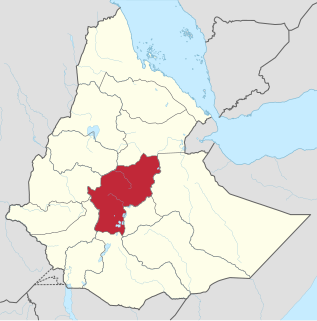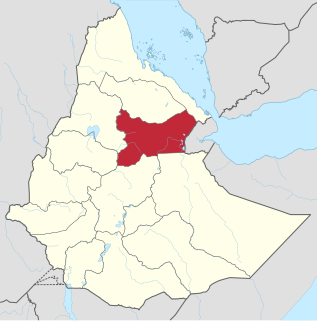This article provides a list of the 139 districts of the Amhara Region of Ethiopia, compiled from the 2007 census by the Central Statistical Agency. [1]
Amharas are an ethnic group indigenous to Ethiopia, traditionally inhabiting parts of the northwest Highlands of Ethiopia, particularly in the Amhara Region. According to the 2007 national census, Amharas numbered 19,867,817 individuals, comprising 26.9% of Ethiopia's population and they are mostly Orthodox Christians members of Ethiopian Orthodox Church. They are also found within the Ethiopian expatriate community, particularly in North America. They speak Amharic, an Afro-Asiatic language of the Semitic branch, a member of the Ethiopian Semitic group, which serves as the official language of Ethiopia.

The Oromia Region is a regional state in Ethiopia, the homeland of the Oromo people. The capital city of the State of Oromia is Addis Ababa also known as Finfinne. Currently the state consists of 21 administrative zones.Towns in the region include Adama, Ambo, Asella, Badessa, Bale Robe, Bedele, Bishoftu, Begi, Bule Hora, Chiro, Dembidolo, Fiche, Gimbi, Goba, Haramaya, Holeta, Jimma, Metu, Negele Arsi, Nekemte, Sebeta, Shashamane and Waliso, among many others. It is bordered by the Somali Region to the east; the Amhara Region, the Afar Region and the Benishangul-Gumuz Region to the north; Dire Dawa to the northeast; the South Sudanese state of Upper Nile, Gambela Region, Southern Nations, Nationalities, and Peoples' Region and Sidama Region to the west; the Eastern Province of Kenya to the south; as well as Addis Ababa as an enclave surrounded by Oromia Special Zone Surrounding Finfinne in its center and the Harari Region as an enclave surrounded by East Hararghe in its east.

Shewa, formerly romanized as Shua, Shoa, Showa, Shuwa, is a historical region of Ethiopia, formerly an autonomous kingdom within the Ethiopian Empire. The modern Ethiopian capital Addis Ababa is located at its center.

Wollo. Later it mixed with the adjacent societies and the current Wollo is a mix of Oromos, Amharas, Agew and Afar. There were places in Amhara Wollo province where the belief of Old Testament and synagogues existed before 34 A.D. This region was one of the place where synagogues were transformed into Churches and Churches were became centres of tradition. During the Middle Ages this region was known as Bete Amhara province and had Amhara Kings. Bete Amhara had an illustrious place in Ethiopian political and cultural history. It was the center of Amhara Solomonic Dynasty established by Emperor Yekuno Amlak around Lake Hayq 1270, the original center of Amhara people, whose territorial reach extended from Lake Hayq and the Beshillo River in the north, the Afar and Argobba lowlands in the east, the Abbay River in the West, and the Awash River just south of modern Addis Ababa.

Begemder was an Amhara province in the northwestern part of Ethiopia.

Amhara Region is a regional state in northern Ethiopia, and the homeland of the Amhara people. Previously known as "Region 3", its capital is Bahir Dar. Ethiopia's largest inland body of water, Lake Tana, which is the source of the Blue Nile river, is located within Amhara. The region also contains the Semien Mountains National Park, which includes Ras Dashan, the highest point in Ethiopia. Amhara is bordered by the state of Sudan to the west and northwest, and in other directions by other regions of Ethiopia: Tigray to the north, Afar to the east, Benishangul-Gumuz to the west and southwest, and Oromia to the south.
Ambassel is a woreda of the Amhara Region in Ethiopia, and an amba, or mountain fortress, located in the woreda; The word Ambasel is derived from two words “Amba” from the Amharic word for plateau, and “Asel” from the Arabic language, which means honey. Together, it means “plateau of honey” or the “land of honey” the woreda is named for this feature. Located in the Debub Wollo Zone, Ambassel woreda is bordered on the west by the Bashilo which separates it from Tenta, on the north by the Semien Wollo Zone, on the southeast by the Mille River which separates it from Tehuledere, and on the south by Kutaber; the Walano, a tributary of the Bashilo, defines most of its southern border. Its largest town is Wuchale.

North Wollo is one of 10 zones of the Amhara Region of northern Ethiopia. It is bordered on the south by South Wollo, on the west by South Gondar, on the north by Wag Hemra, on the northeast by Tigray Region, and on the east by Afar Region; part of its southern border is defined by the Mille River. Its highest point is Mount Abuna Yosef. Its towns include Lasta Lalibela and Weldiya. North Wollo acquired its name from the former province of Wollo.

Oromia Zone is a zone in the Amhara Region of Ethiopia. Oromia is named for the Oromo people, who settled along the edge of the Ethiopian highlands that form this Zone. Oromia Zone is bordered on the southwest by North Shewa Zone, on the northwest by South Wollo and Argobba special woreda, and on the east by the Afar Region. Kemise is the administrative center of the Zone; other towns include Bati.

Ethiopia is administratively divided into regional states and chartered cities, zones, woreda (districts) and kebele (wards).
The Oromo Liberation Front is a political party established in 1973 by Oromo people in Ethiopia who believe that the Oromo people constitute a separate nation. The movement is the culmination of over 70 years of uncoordinated resistance by Oromos against Ethiopian Empire. The OLF has offices in Addis Ababa (Ethiopia), Washington, D.C. and Berlin from where it operates Amharic and Oromo-language radio stations. OLF is the founding father of the Oromo struggle, dealing with the inhuman mass killings and injustices Oromo have been facing.

Bugna is a woreda in the Amhara Region of Ethiopia. It is named after the former district. Located in the northwest corner of the Semien Wollo Zone, Bugna is bordered on the south by Meket, on the west by the Debub Gondar Zone, on the north by the Wag Hemra Zone, and on the east by the Lasta woreda. The main town is 'Ayne. The Lasta woreda, where Lalibela is, was split off from Bugna.
Sayint is one of the districts of Ethiopia in the Amhara Region. It is named after the historic district of Amhara Sayint. Part of the South Wollo Zone, Sayint is bordered on the south by Debre Sina and Mehal Sayint, on the west by the Blue Nile that separates it from the East Gojjam Zone, on the northwest by the Bashilo River that separates it from the South Gondar Zone, on the north by Magdala, on the east by Tenta and on the southeast by Legambo. The major town in Sayint is Sayint Ajebar. Mehal Sayint was created by separating it from Sayint.
Gishe is one of the woredas in the Amhara Region of Ethiopia. Located at the eastern edge of the Ethiopian highlands in the Semien Shewa Zone, Gishe is bordered on the south by the Menz Gera Midir, on the west and north by the Debub Wollo Zone, and on the east by Antsokiyana Gemza; the Wanchet River defines its western boundary. The name of this woreda is coming from the name of a district of the former province or kingdom of Shewa, Gishe. It contains Abuye Meda, the largest plateau in Ethiopia. The administrative center of Gishe is Rabel.
Menjarna Shenkora is one of the woredas in the Amhara Region of Ethiopia. It is named in part after a historic district of Shewa, Menjar, which was the southernmost district of Shewa and near the location of the modern woreda. Located at the southern end of the Semien Shewa Zone, Menjarna Shenkora is bordered on the east, south and west by the Oromia Region, on the northwest by Hagere Mariamna Kesem, and on the northeast by Berehet; the Germama river forms the boundary between this woreda and Hagere Mariamna Kesem and Berehet. The administrative center of this woreda is Arerti; other towns in the woreda include Balchi and Eranbuti.

Districts are the third-level of Administrative division of regional state in Ethiopia They are further subdivided into a number of wards (kebele) or neighbourhood associations, which are the smallest unit of local government in Ethiopia.
The 2016 Oromo protests were peaceful protest nonviolent resistance first sparked April 25 2014 against Addis Ababa Master Plan and resumed on November 12, 2015 by university student and farmers in Ginchi town, located 80 km southwest of Addis Ababa city, encircled by Oromia region.plan was to expand the capital into Oromia special zone. This led to fears that Oromo farmers would lose their land and be displaced. The plan was later dropped but protests continued, highlighting issues such as marginalization and human rights. Mulatu Gemechu, Deputy Chairman of the opposition Oromo Federalist Congress, expressed to Reuters: "so far, we have compiled a list of 33 protesters killed by armed security forces that included police and soldiers but I am very sure the list will grow" Protesters demanded social and political reforms including an end to human rights abuses. The government responded by restricting access to the Internet and attacking as well as arresting protesters.

The Oromo conflict is a longstanding conflict between Oromo nationalists and the Government of Ethiopia. The OLF originally fought the Ethiopian Empire to liberate Oromo people and establish an independent Oromia state. The conflict began in 1973, when Oromo nationalists established the OLF and its armed wing, the Oromo Liberation Army (OLA).Under Haile Selassie Regime Oromo was banned from education, and use in administrationThe Amhara culture dominated throughout the eras of military and monarchic rule. Both the Haile Selassie and the Derg government relocated numerous Amharas into southern Ethiopia include present day of oromia region where they served in government administration, courts, church and even in school, where Oromo texts were eliminated and replaced by Amharic. The Abyssinian elites perceived the Oromo identity and languages as hindrances to Ethiopian national identity expansion.

The 2019 Amhara Region coup d'état attempt consisted of coordinated assassinations of Amhara Region's high degree officials and the Generals of Ethiopian National Defense Force in Addis Ababa on 22 June 2019. Factions of the security forces of Amhara Region, Ethiopia attempted a coup d'état against the regional government, during which Amhara Region Chief Administrator Ambachew Mekonnen was killed. A bodyguard siding with the Amhara nationalist factions assassinated General Se'are Mekonnen, the Chief of the General Staff of the Ethiopian National Defense Force, as well as his aide Major General Gizae Aberra. The Prime Minister's Office accused Brigadier General Asaminew Tsige, head of the Amhara region security forces, of leading the plot. Asaminew was later shot dead after escaping.